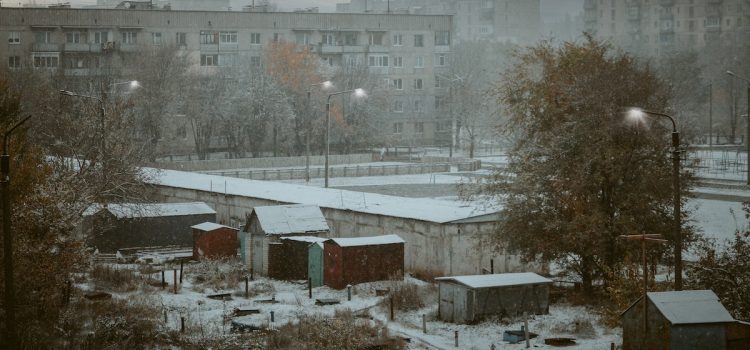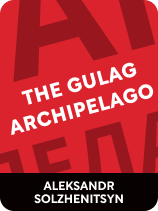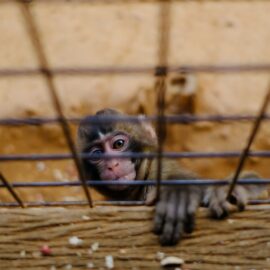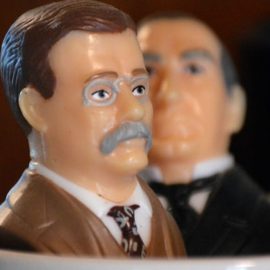

This article is an excerpt from the Shortform book guide to "The Gulag Archipelago" by Aleksandr Solzhenitsyn. Shortform has the world's best summaries and analyses of books you should be reading.
Like this article? Sign up for a free trial here.
What were Soviet labor camps designed to do? How were they like Nazi death camps? What happened to released prisoners?
The Gulag Archipelago is a work of historical nonfiction that describes life in Soviet labor camps, popularly known as gulags, in the USSR from the late 1910s to the mid-50s. Prisoners such as author Aleksandr Solzhenitsyn were arrested on minor or fabricated charges, tortured and robbed, and held in camps for decades.
Keep reading to learn how gulags subjected prisoners to forced labor, physical abuse, long prison terms, and exile.
Soviet Labor Camps
Much of The Gulag Archipelago is dedicated to describing just how poorly prisoners were treated in Soviet labor camps, to the extent that Solzhenitsyn repeatedly draws comparisons between the gulag system and the execution camps operated by the Nazis in World War II. He argues that, although the gulag system wasn’t a tool of genocide in the traditional sense—it wasn’t intended to wipe out a specific national or ethnic group—it still operated as a system of state-sanctioned murder, moving supposed criminals out of the public eye and exploiting them for labor as much as possible before killing them.
(Shortform note: While the Soviet government tried to frame the gulag as being a more humane reformation of Russia’s pre-revolution Tsarist prison system, in practice the two systems were more alike than different. Huge numbers of prisoners were arrested for criticizing the government, exiled to Siberia, and forced to labor as miners or loggers. In many cases, former Tsarist prison sites were actually taken over and reopened as gulags. The main difference between the two systems was scale—even if you accept the most conservative estimates, gulags imprisoned 10 times as many prisoners, operating thousands of camps simultaneously.)
On the rare occasions when the gulag system was discussed in public, it was framed as rehabilitative. Prisoners would enter as criminals or “parasites,” labor to provide a useful service to society, and exit as productive workers. However, as Solzhenitsyn points out, the prison system wasn’t designed to facilitate reintegration back into society. Terms were so long and the work so brutal that most prisoners exited with their health totally destroyed and having lost touch with anyone on the outside. In addition, release from prison wasn’t unconditional, as most prisoners were released into exile and ordered, on threat of re-imprisonment, never to return to the cities where they had previously lived and worked.
| Rethinking the Goals of Prison Most prison systems worldwide claim to be able to reform or rehabilitate prisoners, just as the Soviet government framed the gulag system. However, the modern-day prison abolition movement argues that prison systems actually operate as systems of revenge and social control. Prisons aren’t designed to help prisoners or the victims of their crimes, but to maintain “law and order,”—the government’s ability to control people. The three main arguments of the anti-prison movement are: • Most people who wind up in prison are driven there by poverty and lack of access to educational or professional resources and are not inherently dangerous. • Time in prison is physically and psychologically damaging and actually makes it harder for people to live peaceful and law-abiding lives after release. • Prison disproportionately affects the most marginalized members of society, who serve longer terms for less serious offenses. Anti-prison activists propose alternative models for dealing with crime, most of which involve community-run service, mental health and educational organizations intervening in the lives of at-risk people, and ensuring that former criminals make some kind of restitution to their victims. |
Forced Labor
The vast majority of gulag prisoners spent their terms doing “general labor” as miners or loggers in remote parts of Siberia. The camps’ designers themselves acknowledged the brutal nature of this work and that many prisoners died on the job. According to Solzhenitsyn, gulag administrators believed that prisoners were only useful to the state in the first three months. Beyond that, labor and mistreatment would have taken too much of a toll, and the best thing was for them to die quickly.
(Shortform note: In the gulag, workers who died or were released would simply be replaced with new arrivals. Functionally, this system was equivalent to slavery: a system that also requires a steady supply of new people who are either so desperate or who have no other choice but to accept unlivable conditions.)
In addition to the inherent physical demands of mining and logging, prisoners worked 12- or 14-hour shifts, were poorly fed and clothed, and never had adequate shelter. They received no formal training in their work and had limited access to tools. Solzhenitsyn also points out that they were, naturally, unmotivated—a prisoner’s survival could depend on their ability to avoid working as much as possible, conserving their energy to avoid burning through the few calories they were given each day. As a result, the camps often operated at a loss, barely justifying the cost of housing and feeding (however poorly) the prisoners in the first place.
(Shortform note: Some camps exploited prisoners for their intellectual labor instead. Special Design Bureaus, or sharashkas, housed prisoners who had formerly been scientists or engineers and forced them to do technological research on behalf of the state. Solzhenitsyn doesn’t discuss sharashkas at length in The Gulag Archipelago, since they were the focus of his 1968 novel In the First Circle, but he stated several times throughout his life that he only survived the gulag because he spent around half his term in a sharashka.)
Physical Abuse and Neglect
Physical and sexual abuse were part of everyday life in the camps. Guards regularly punished prisoners—for real or imagined infractions—by beating them, taking away their clothing or personal possessions, depriving them of sleep, or keeping them in solitary confinement. Solzhenitsyn notes that, in many prisons, the living quarters had no latrine. Prisoners would have to wait for the guards to accompany them outside to relieve themselves, often only once a day, and this privilege could be revoked as a punishment.
(Shortform note: Fictional depictions of torture often focus on beatings, but tactics designed to humiliate or put stress on prisoners gradually—taking away clothing, sexual humiliation, sleep deprivation, sensory deprivation or sensory overload, and so on—can be just as devastating. Modern international law surrounding torture makes a point to define torture not simply as physical abuse, but as any “cruel, inhuman or degrading treatment.”)
Sexual violence was widespread in the camps, especially for female prisoners or children (from the mid-1930s on, children over the age of 12 could be tried as adults, and Solzhenitsyn claims that thousands served terms in gulags throughout the ’40s-60s). Prisoners were harassed at random by their fellow prisoners and forced into sexual relationships with guards, either in exchange for better treatment or on threat of being assigned to worse labor conditions.
(Shortform note: Modern pop culture depictions of sexual violence in prison tend to emphasize the threat of rape from other prisoners and particularly sensationalize same-sex or cross-racial activity. In fact, most of the sex that occurs between prisoners is consensual, and it’s much more common for prisoners to be sexually abused by guards or other authority figures.)
Even when the prison administration wasn’t actively hurting the prisoners, it neglected them—prisoners were regularly denied medical treatment and forced to keep laboring until they were physically incapable of doing so. Those who survived illnesses often suffered, for the rest of their lives, from the lingering effects of malnutrition and permanent damage to their respiratory and gastrointestinal systems.
(Shortform note: While prisoners have access to healthcare in the United States, the quality of that care is limited, and it’s not uncommon for chronic health conditions to be poorly treated or for warning signs of a health crisis to go ignored to the extent that the prisoner is left with lasting damage. During the Covid-19 pandemic, for example, lack of resources and mishandling of social distancing procedures meant that thousands of prisoners got sick.)
Length of Terms
It was common for prisoners in the gulag to serve 10- or 25-year terms, regardless of the severity of the offense. Children were generally given three to five years, and Solzhenitsyn’s own eight-year sentence was on the lower end of sentences for anti-Soviet activity. In addition, prisoners often had their sentences extended as a punishment by the camp guards. These extensions were made without a new conviction or investigation process. Rather than taking on additional months or years, prisoners would have their sentence reset, so that they would have to begin serving their 10 or 25 years again from that point forward—regardless of how much time they’d already served.
(Shortform note: Most legal systems scale the length of prison terms to the severity of the crime, and offer a number of opportunities for prisoners to reduce the length of their sentences based on good behavior. The length of Soviet prison terms was extreme by any standard, and the ability to extend sentences without the intervention of a judge is unheard of in most other nations.)
Exile
Release from prison meant an end to forced labor, but ex-prisoners were not given all the rights of free citizens. Most were ordered never to return to their former homes and forced to live instead in remote villages and cities on the outskirts of the USSR. Many of these areas were directly outside the prisons in which they’d previously been held. They had to regularly check in with local police but were now expected to find their own food and housing, sleeping in shacks and taking on underpaid menial labor to survive. Some even accepted work within their former prison, this time as contract laborers.
In short, exile was a continuation of prison, just with slightly more freedom of movement. Solzhenitsyn notes that ex-prisoners’ way of life was unstable, since they could be forced by police order or the whims of State Security to move to a different community. Some fled exile and moved back to other parts of the USSR, but they had to remain in hiding or else risk being returned to prison.
(Shortform note: Even in countries which fully restore the rights of citizenship to ex-prisoners—either upon release or after a probationary period—the stigma of having spent time in prison can make getting housing and work difficult. In the United States, felons are barred from certain professions, and ex-prisoners are regularly passed over in favor of less experienced candidates. Ex-prisoners often struggle with poverty and are significantly more likely than the average citizen to be homeless.)

———End of Preview———
Like what you just read? Read the rest of the world's best book summary and analysis of Aleksandr Solzhenitsyn's "The Gulag Archipelago" at Shortform.
Here's what you'll find in our full The Gulag Archipelago summary:
- A book that was banned for exposing human rights abuses to the world
- A work of historical nonfiction that describes life in Soviet prison labor camps
- How the Soviet government used violence, paranoia, and repression to control their citizens






